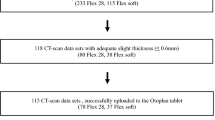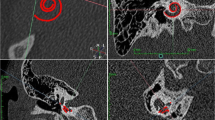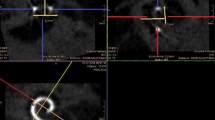Abstract
Beside the cochlear size, the linear insertion depth (LID) influences the insertion depth angle of cochlear implant electrode arrays. For the specific implant CI422 the recommended LID is not fixed but can vary continuously between 20 and 25 mm. In the current study, the influence of cochlea size and LID on the final insertion depth angle was investigated to develop a prediction tool for the insertion depth angle by means of cochlea diameter and LID. Preoperative estimation of insertion depth angles might help surgeons avoid exceeding an intended insertion depth, especially with respect to low-frequency residual hearing preservation. Postoperative, high-resolution 3D-radiographs provided by Flat Panel Computed Volume Tomography (FPCT) were used to investigate the insertion depth angle in 37 CI422 recipients. Furthermore, the FPCT images were used to measure linear insertion depth and diameter of the basal turn of the cochlea. A considerable variation of measured insertion depth angles ranging from 306° to 579° was identified. The measured linear insertion depth ranged from −18.6 to 26.2 mm and correlated positively with the insertion depth angle. The cochlea diameter ranged from 8.11 to 10.42 mm and correlated negatively with the insertion depth angle. The results suggest that preoperatively measured cochlea diameter combined with the option of different array positions by means of LID may act as predictors for the final insertion depth angle.







Similar content being viewed by others

References
Erixon E, Högstorp H, Wadin K, Rask-Anderson H (2008) Variational anatomy of human cochlea: implications for cochlear implantation. Otol Neurotol 30:14–22
Kawano A, Seldon HL, Clark GM (1996) Computer aided three-dimensional construction in human cochlear maps: measurement of the lengths of organ of Corti outer wall, inner wall and Rosenthal`s canal. Ann Otol Rhinol Laryngol 105:701–709
Hardy M (1938) The length of the organ of corti in man. Am J Anat 62:291–311
Ketten DR, Skinner MW, Wang GE, Vannier MW, Gates GA, Neely JG (1998) In vivo measures of cochlear length and insertion depth of nucleus cochlear implant electrode arrays. Ann Otol Rhinol Laryngol 175(suppl):1–16
Trieger A, Schulze A, Schneider A, Zahnert T, Mürbe D (2010) In vivo measurements of the insertion depth of cochlear implant arrays using flat panel volume computed tomography. Otol Neurotol 32:152–157
Escudé B, James C, Deguine O, Cochard N, Eter E, Fraysse B (2006) The size of the cochlea and predictions of insertion depth angles for cochlear implant electrodes. Audiol Neurotol 11:27–33
Franke-Trieger A, Jolly C, Darbinjan A, Zahnert T, Mürbe D (2013) Insertion depth angles of cochlear implant arrays with varying length: a temporal bone study. Otol Neurotol 35(1):58–63
Skarzynski H, Lorens A, Piotrowska A (2003) A new method of partial deafness treatment. Med Sci Monit 9:CS20–CS24
Gstoettner W, Kiefer J, Baumgartner WD, Pok S, Peters S, Adunka O (2004) Hearing preservation in cochlear implantation for electric acoustic stimulation. Acta Otolaryngol 124:348–352
Skarzynski H, Lorens A, Matusiak M, Porowski M, Skarzynski PH, James CJ (2012) Partial deafness treatment with the Nucleus straight research array cochlear implant. Audiol Neurotol 17:82–91
James C, Albegger K, Battmer R et al (2005) Preservation of residual hearing with cochlear implantation: how and why. Acta Otolaryngol 125:481–491
Skarzynski H, Lorens A, Matusiak M, Porowski M, Skarzynski PH, James CJ (2014) Cochlear implantation with the nucleus slim straight electrode in subjects with residual low-frequency hearing. Ear Hear 35(2):e33–e43
Adunka O, Kiefer J (2006) Impact of electrode insertion depth on intracochlear trauma. Otolaryngol Head Neck Surg 135:374–382
Finley CC, Skinner MW (2008) Role of electrode placement as a contributor to variability in cochlear implant outcomes. Otol Neurotol 29:920–928
Yukawa K, Cohen L, Blamey P, Pyman B, Tungvachirakul V, O`Leary S (2004) Effects of insertion depth of cochlear implant electrode upon speech perception. Audiol Neurootol 9:163–172
Skinner MW, Ketten DR, Holden LK et al (2002) CT-derived estimation of cochlear morphology and electrode array position in relation to word recognition in Nucleus-22 recipients. J Assoc Res Otolaryngol 3:332–350
Holden LK, Finley CC, Firszt JB et al (2013) Factors affecting open-set word recognition in adults with cochlear implants. Ear and hear 34(3):342
Khan AM, Handzel O, Burgess BJ, Damian D, Eddington DK, Nadol JB (2005) Is word recognition correlated with the number of surviving spiral ganglion cells and electrode insertion depth in human subjects with cochlear implants? Laryngoscope 115:672–677
Lee J, Nadol JB Jr, Eddington DK (2010) Depth of electrode insertion and postoperative performance in humans with cochlear implants: a histopathologic study. Audiol Neurotol 15:323–331
Xu J, Xu SA, Cohen LT, Clark GM (2000) Cochlear view: postoperative radiography for cochlear implantation. AM J Otol 21:49–56
Verbist BM, Skinner MW, Cohen LT et al (2010) Consensus panel on a cochlear coordinate system applicable in histologic, physiologic, and radiologic studies of the human cochlea. Otol Neurotol 31:722–730
Martinez-Monedero R, Niparko JK, Aygun N (2011) Cochlear coiling differences in cochlear implant candidates. Otol Neurotol 32:1086–1093
Bredberg G (1968) Cellular pattern and nerve supply of the human organ of Corti. Acta Otolaryngol (Stockh) 236(suppl):1–138
Greenwood DD (1990) A cochlear frequency-position function for several species—29 years later. J Acoust Soc Am 87:2592–2605
Cohen LT, Xu J, Xu SA, Clark GM (1996) Improved and simplified methods for specifying positions of the electrode bands of a cochlear implant array. Am J Otol 17:859–865
Acknowledgments
Thanks to Dr. H. Hessel for constructive comments on the manuscript.
Conflict of interest
The authors declare no conflict of interest.
Author information
Authors and Affiliations
Corresponding author
Rights and permissions
About this article
Cite this article
Franke-Trieger, A., Mürbe, D. Estimation of insertion depth angle based on cochlea diameter and linear insertion depth: a prediction tool for the CI422. Eur Arch Otorhinolaryngol 272, 3193–3199 (2015). https://doi.org/10.1007/s00405-014-3352-4
Received:
Accepted:
Published:
Issue Date:
DOI: https://doi.org/10.1007/s00405-014-3352-4



